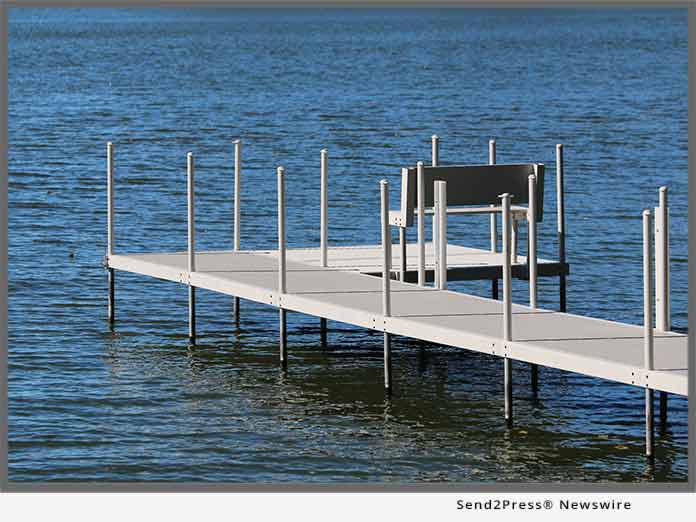LONG LAKE, Minn., April 18, 2019 (SEND2PRESS NEWSWIRE) — Whether you call it a lake home, cabin, cottage or camp, buyers are naturally drawn to the water’s edge when looking at lakeshore properties. The wide variety of shoreline conditions gives buyers a lot to consider before they write a purchase agreement, says John Gehring, owner of Solo Dock, a tip-in dock manufacturer in Long Lake, Minnesota.

Some buyers seek a tranquil retreat with a spectacular view. Others want a shoreline suited to an active watersports lifestyle. One important consideration is the set of local ordinances governing each lake. Some municipalities have enacted no-wake or quiet hours rules that allow boat motors to only run at idle from 5 p.m. to 10 a.m., for example.
Next, consider the natural environment at the water’s edge.
“The shoreline transition to the water, the depth of the water, and lake bottom conditions all factor into enjoyable use of the lake or river,” says John Gehring, owner of Solo Dock, a tip-in dock manufacturer in Long Lake, Minnesota. “Thoughtful selection of a dock or pier will take advantage of the desirable conditions and overcome any challenging aspects of the lakeshore.”
A relatively level shoreline allows for easy access to the water and the dock. Lakeshore owners can simply anchor a starter bracket at the water’s edge and install the dock. On a shoreline with a hill, the dock can be installed on the beach, at the water’s edge, or attached to a new or existing stairway. In either case, Gehring says dock selection decisions need to factor in ease of transporting to a safe and secure location for storage, often at the top of the hill or stairs. Docks that break down into sections as small as six feet long allow one person to install and remove the dock by themselves.
Lakeshore buyers should consider that steep banks may also require stabilization, landscaping and stairs to prevent the bank from sliding into the lake. However, these improvements also preserve the owner’s investment, beautifies the property and enhances the view from up top.
Gehring also advises prospective buyers to get water measurements every six feet from shore until the water is at least four-to-six feet deep. Boats typically need a minimum of three feet of water to float if tied to the dock, and four or more feet of water if kept on a lift. Water depth measurements will tell you how many feet of dock you will need to purchase, and how long the pipes need to be for each dock section when you order a dock.
“Getting water depth measurements helps prospective lakeshore owners formulate a plan and a budget for a dock, a boat and maybe a boat lift,” says Gehring. “I occasionally talk to new lakeshore owners that didn’t get water depth measurements, and when spring arrived they discovered they need 100 or 200 feet of dock, which they didn’t budget for. Fortunately, Solo Dock offers a 0 percent financing option to help customers get the dock they need to enjoy the summer on the lake.”
Gehring suggests buyers ask if the DNR or lake association regulates the water depth in the lake or river with a dam, and how much the water level fluctuates during the summer. It’s an advantage to have a dock that can be installed without getting into the water, especially when the water is high and cold in spring. If getting help to install a dock early in spring and remove it late in fall is in question, consider a dock that one person can install, level and remove to take advantage of the early sunny spring days and the last warm days of fall.
Gehring also suggests finding out what the lake bottom consists of. Is the lake bottom mucky? If so, how deep is the muck? Often there is a few inches to a foot of muck on top of a firm bottom like sand, gravel or clay. This is the result of decayed leaves, etc. accumulating on the lake bottom over many years, especially in lakeshore that hasn’t seen active use. Large footpads (12-inch diameter, for example) give dock posts stable support in firm or soft lake bottoms. A removal winch tripod tool allows one person to pull the dock out of sand, silt or muck without getting into the water.
Also, prospective buyers should determine if they will need to purchase flood insurance. If you will have a mortgage on the property and the building is classified as being in a flood plain, your lender will require you to purchase flood insurance. FEMA recently reclassified property that previously didn’t require flood insurance.
Finally, Gehring advises prospective buyers to include a dock or boat lift that’s on the property in the purchase agreement if it might fit their needs. But if the dock is old, wooden, heavy, etc., buyers should specify that the seller remove and dispose of the dock prior to closing, and start their search for a dock they will enjoy for decades to come.
About Solo Dock:
Solo Dock manufactures and sells an aluminum “Tip-In Dock” that one person can install, level and remove without getting into the water. The company is headquartered in the city of Long Lake, Minnesota, in the western suburbs of Minneapolis. John Gehring is the owner of Solo Dock, and he and his family have lived on Lake Minnetonka for 25 years. In that time he has helped customers, friends and neighbors install many styles of docks on many different types of lakeshore, giving him the experience to advise customers and ship docks across the U.S. and Canada.
For more information, see the company’s web site at http://www.SoloDock.com or call 1-952-472-3953.
Media Contact:
John Gehring
Owner, Solo Dock
952-472-3953
JGehring@SoloDock.com
###
MEDIA ONLY CONTACT:
(not for print or online)
*PHOTO link for media: Send2Press.com/300dpi/19-0418s2p-Solo-Dock-300dpi.jpg
*Photo caption: Savvy lake home buyers incorporate a complete shoreline evaluation into their property search, and are rewarded with a lifetime of enjoyment on the water.
News Source: Solo Dock
